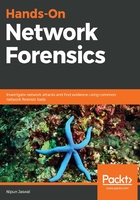
Exercise 2 – two too many
Let's analyze another capture file from https://github.com/nipunjaswal/networkforensics/blob/master/Ch1/Two%20to%20Many/twotomany.pcap, that we currently don't know any details about and try reconstructing the chain of events.
We will open the PCAP in Wireshark, as follows:

From the preceding screenshot, we can see that numerous SYN packets are being sent out to the 64.13.134.52 IP address. However, looking closely, we can see that most of the packets are being sent every so often from a single port, which is 36050 and 36051, to almost every port on 64.13.134.52. Yes, you guessed right: this looks like a port scan. Initially the SYN packet is sent out, and on receiving a SYN/ACK, the port is considered open.
We know that the originating IP address, 172.16.0.8, is an internal one and the server being contracted is 64.13.134.52. Can you figure out the following?:
- Scan type
- Open ports
Answering the first question requires a more in-depth understanding of a TCP-oriented communication and its establishment, TCP works on a three-way handshake, which means that on receiving a synchronize (SYN) packet from the source IP address, the destination IP address sends out a synchronize/ acknowledgment (SYN/ACK) packet that is followed by a final acknowledgment (ACK) packet from the source IP address to complete the three-way handshake. However, as we can see from the preceding screenshot, only a SYN/ACK is sent back from port 80, and there hasn't been an ACK packet sent out by the source IP address.
This phenomenon means that the ACK packet was never sent to the destination by the source, which means that only the first two steps of the three-way handshake were completed. This two step half open mechanism causes the destination to use up resources as the port will be help open for a period of time. Meanwhile, this is a popular technique leveraged by a scan type called SYN scan or half-open scan, or sometimes the stealth scan. Tools such as Nmap make use of such techniques to lower the number of network packets on the wire. Therefore, we can conclude that the type of scan we are dealing with is a SYN scan.

Applying the filer ip.src==64.13.134.5, we can see the responses sent by 64.13.134.52. It is evident that we have received the SYN/ACK from ports 53, 80, and 22, which are open ports. We can also see that there has been network loss, and the sender has sent the packets again. Additionally, we can see Reset Acknowledgment Packets (RST) that denote misconfigurations or the application running on the not willing to connect: the reasons for such behavior can differ.